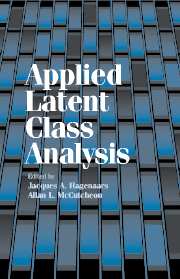Book contents
- Frontmatter
- Contents
- Contributors
- Preface
- INTRODUCTION
- 1 Latent Class Analysis: The Empirical Study of Latent Types, Latent Variables, and Latent Structures
- 2 Basic Concepts and Procedures in Single- and Multiple-Group Latent Class Analysis
- CLASSIFICATION AND MEASUREMENT
- CAUSAL ANALYSIS AND DYNAMIC MODELS
- UNOBSERVED HETEROGENEITY AND NONRESPONSE
- Appendix A: Notational Conventions
- Appendix B: Further Readings
- Appendix C: Selected Software; Webpage
- Index
2 - Basic Concepts and Procedures in Single- and Multiple-Group Latent Class Analysis
Published online by Cambridge University Press: 31 July 2009
- Frontmatter
- Contents
- Contributors
- Preface
- INTRODUCTION
- 1 Latent Class Analysis: The Empirical Study of Latent Types, Latent Variables, and Latent Structures
- 2 Basic Concepts and Procedures in Single- and Multiple-Group Latent Class Analysis
- CLASSIFICATION AND MEASUREMENT
- CAUSAL ANALYSIS AND DYNAMIC MODELS
- UNOBSERVED HETEROGENEITY AND NONRESPONSE
- Appendix A: Notational Conventions
- Appendix B: Further Readings
- Appendix C: Selected Software; Webpage
- Index
Summary
Latent class analysis is frequently used when the researcher has a set of categorically scored observed measures that are highly interrelated. The latent class model (LCM) – which is often characterized as the categorical data analog to factor analysis – is most appropriately used when the observed indicator variables are associated because of some underlying unobserved factor rather than being causally related. For example, the correctness (incorrectness) of answers to questions on an exam may be highly interrelated as a result of mastery; those who have mastered the material will tend to answer items correctly, and those who have yet to master the material will tend to answer them incorrectly. Thus, in a sufficiently large sampling of student exams, we would anticipate that those who correctly answered question 1 would also be more likely to have correctly answered questions 2, 3, and so forth, yielding a clear association among the “variables” (exam questions). Frequent instances of this kind of association can be found in the social and behavioral sciences (e.g., self-esteem, religiosity, partisan identification, consumer loyalty).
Since the early 1990s, the LCM has emerged as a powerful new method for the analysis of categorically scored data. As is clear from the range of applications in this volume, the range of topics to which the LCM can be fruitfully applied is quite broad.
- Type
- Chapter
- Information
- Applied Latent Class Analysis , pp. 56 - 86Publisher: Cambridge University PressPrint publication year: 2002
- 125
- Cited by



